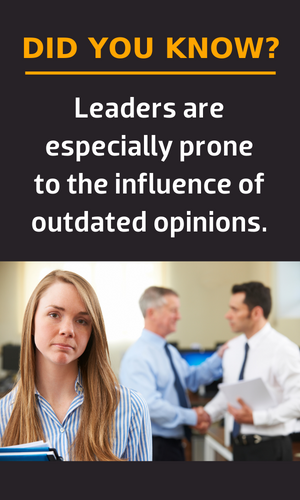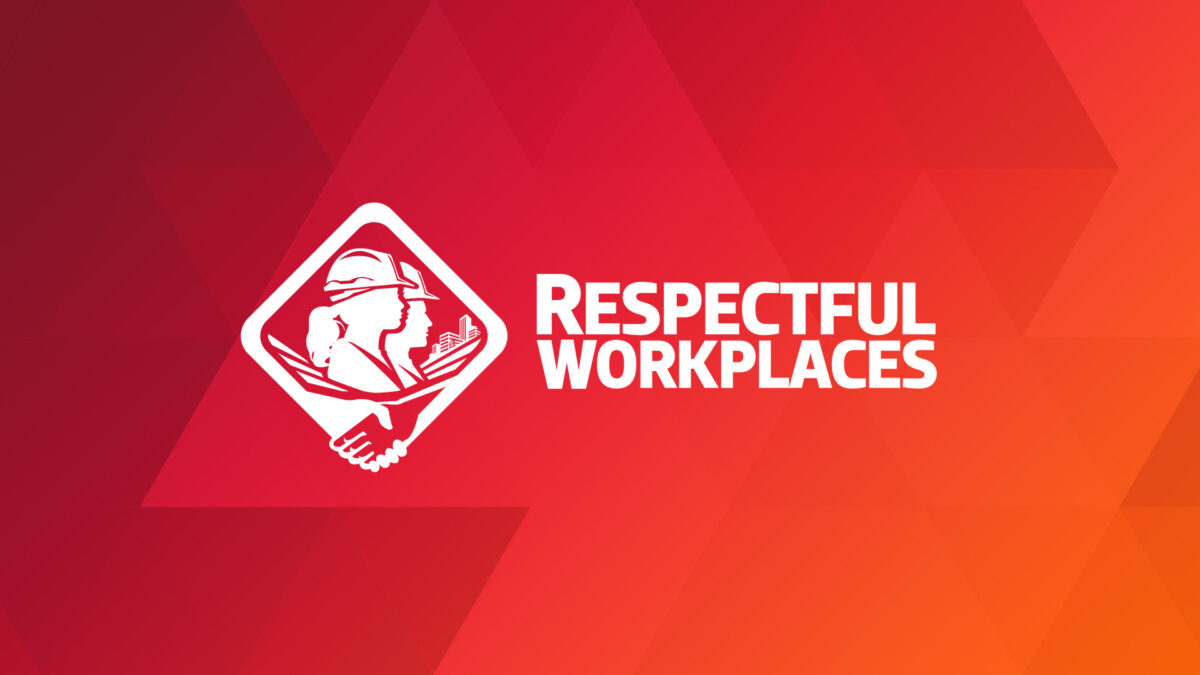Does your organization recognize that outdated opinions may be influencing decision making?

Most leaders and managers want the diversity that members of traditionally under-represented groups bring to a workplace. Fifty-seven percent of workers want to see more diversity in their workplace, and almost seventy percent of executives consider diversity to be a critical factor in their organization’s success.
Despite this, bias and stereotypes continue to negatively influence the careers of women, Black, Indigenous, and People of Colour. For example, in a study of tradeswomen’s experience at work, 64% of managers said that women face discrimination related to gender bias. The BlackNorth Initiative reports that 60% of Black employees have been discriminated against because of stereotypes related to their intellectual ability. And Catalyst found that 52% of Indigenous People in Canada regularly experience bias.
According to Adam Grant, an organizational psychologist at the Wharton School of the University of Pennsylvania, bias and stereotypes persist because of our inability to “rethink” our deeply held beliefs and outdated opinions. He has found that rethinking our opinions is a very difficult task. Research shows that we don’t just hesitate to rethink our opinions: we hesitate at the very idea of rethinking them. And often, the more successful we are, the more trouble we have.
His research has shown that we are quick to recognize when other people need to rethink their beliefs and opinions or “think again.” For example, we question the judgement of experts whenever we seek out a second opinion on a medical diagnosis. Unfortunately, when it comes to our own knowledge and opinions, we often favour “feeling” right over “being” right.
He has found that bias and stereotypes are particularly difficult to rethink. (See Blog #46 for an in-depth discussion on how bias and stereotypes are developed in early life.) Even if we don’t consciously believe these biases and stereotypes, they are continually reinforced in ways that make it difficult to effectively change them.
Most people find it difficult to recognize or accept the fact that they even have biases. This is the “bias blindspot”: the belief that we are more objective than others. However, because of the influence that leaders have throughout an organization, they have a responsibility to recognize not only that they have biases, but they are more likely than others to fall into the bias blindspot trap.
According to Grant, it is critical that we become aware of the beliefs and outdated opinions that are influencing our decision making. Without this awareness leaders and their organizations will not be positioned for success and the changes that the future demands.
How beliefs and outdated opinions can influence decision making
Grant has identified eight ways that our beliefs and outdated opinions can influence decision making.
1. Stereotypes function as reality goggles.
Our beliefs, including stereotypes, are such powerful motivators that they function like a pair of “reality goggles.” We use them to make sense of the world and navigate our surroundings. A threat to our opinions cracks our goggles, leaving our vision blurred. It’s only natural to put up our guard in response.
We become especially hostile when trying to defend opinions that we know, deep down, are false. Rather than trying on a different pair of goggles, we become mental contortionists, twisting and turning until we find an angle of vision that keeps our current views intact.
2. Stereotypes help us to “fit in.”
Humans are wired to want to belong to social groups. We tend to interact with people who share our beliefs, which makes our beliefs even more extreme. This phenomenon is called “group polarization,” and it’s been demonstrated in hundreds of experiments. Juries with authoritarian beliefs recommend harsher punishments after deliberating together. Corporate boards are most likely to support paying outlandish premiums for companies after group discussions.
3. Polarization is reinforced by in-group dynamics.
Members fit in and gain status by following the lead of the most prototypical member of the group, who often holds the most intense views. This creates powerful in-group dynamics that shield in-group members from differing opinions.
4. Opinions become sacred.
When a core belief is questioned, our “totalitarian ego” reacts physically to protect us from contradictory evidence. We actually feel anger and fear. Neuroscientists have discovered that when our core beliefs are challenged, our amygdala, the primitive “lizard brain” triggers the “fight or flight” response.
5. Bias confounds intelligence.
There are at least two biases that drive the inability to correctly assess contradictory evidence. Confirmation bias causes us to see what we expect to see, and desirability bias causes us to see what we want to see. These biases don’t just prevent us from applying our intelligence. They can actually contort our intelligence by causing us to preach our belief more deeply and defend our case more passionately.
6. Contradictory evidence is confusing, especially if you’re smart.
Research reveals that the higher you score on an IQ test, the more likely you are to believe stereotypes, because you’re faster at recognizing patterns. If the pattern supports your beliefs, being smart makes you more accurate in interpreting results. However, if the pattern conflicts with your beliefs, the more likely you will completely misinterpret the pattern.
7. Managers tend to overrate their abilities.
In a large global study that evaluated management practices against managers’ own assessments of their abilities, researchers found that managers consistently overrated themselves. Moreover, overconfidence was highest in countries where management ability was the lowest.
8. The Overconfidence Cycle.
An “inner dictator” protects us by activating an overconfidence cycle. First, our wrong opinions are shielded because we feel pride when we see only information that supports our convictions. Then our beliefs are sealed in echo chambers, where we hear only from people who intensify and validate them.
Most leaders and managers want to create inclusive organizations in which members of traditionally under-represented groups can thrive. However, biases and stereotypes persist because of our inability to “rethink” our deeply held beliefs and outdated opinions. Because of the influence that leaders have throughout an organization, they have a responsibility to recognize how their biases and stereotypes may be preventing them from meeting their goals to create inclusive organizations.
Leaders and managers who wish to understand bias and stereotypes and how they can influence decision making could consider participating in two of the courses in our Respectful and Inclusive Workplace Toolkit: Working in a Respectful and Inclusive Workplace and Introduction to Understanding Systemic Racism – A Guide for Leaders and Managers. These courses explore how bias and stereotypes are developed, how they impact organizations, and how leaders and managers can reduce or eliminate their impact on decision making.
Resources:
- BlackNorth Initiative and Boston Consulting Group. A Guide to Advance Racial Equity in Corporate Canada. 2021. See https://blacknorth.ca/playbook.
- Li, Lori. What is Workplace Allyship and Why Does It Matter? Limeade. July 12, 2021. See www.tinypulse.com/blog/allyship-in-the-workplace.
- Grant, Adam. Think Again: The Power of Knowing What You Don’t Know. New York, New York. Viking 2021.
- Pollara. Survey of Industry Leaders. Ontario Building & Construction Tradeswomen. March 2022.
- Thorpe-Moscon, J., & Ohm, J. (2021). Building Inclusion for Indigenous Peoples in Canadian Workplaces. Catalyst. See www.catalyst.org/research/inclusion-indigenous-peoples-canada-workplace.
Read from the beginning. Click here to start at Part 1.
What can an effective Respectful and Inclusive Workplace Program deliver?
- Become an employer of choice – attract, retain, and advance top talent from all sources of labour
- Unlock collaboration and innovation – create high-performing teams through diversity of thought and experience
- Build your brand – your organization will gain a competitive edge as a leader and innovator
Get started today!
The BuildForce Canada Online Respectful and Inclusive Workplace Toolkit includes:
- the Respectful Workplace Online Self-Assessment Tool to assist organization leadership in assessing their current situation and identifying where they may need to make changes
- the Respectful Workplace Policy Framework and Implementation Guide to assist organizations in creating and implementing a policy that supports a respectful and inclusive workplace
- the Respectful Workplace Online Training Course to train workers on how to create and support a respectful and inclusive workplace
- the online course Introduction to Understanding Systemic Racism: A Guide for Leaders and Managers
All the resources you need to create and support a respectful and inclusive workplace!

Respectful and Inclusive Workplaces
